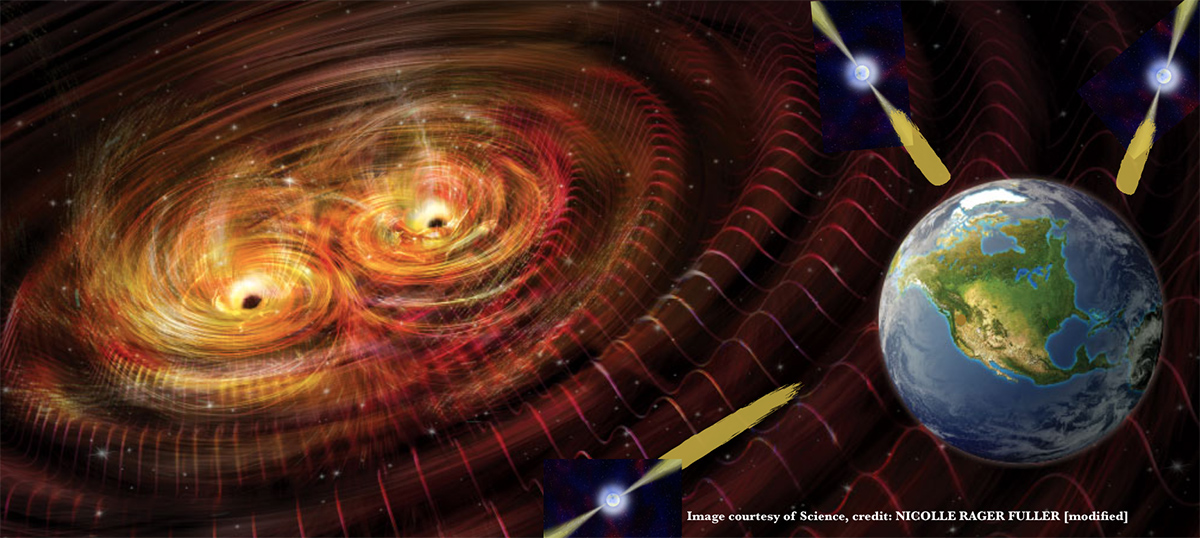The new era of gravitational-wave astronomy is explored here by Miguel Holgado, PhD, Candidate at the Department of Astronomy, the University of Illinois at Urbana-Champaign
Einstein’s Theory of General Relativity predicts the existence of gravitational waves (GWs), ripples in spacetime produced by accelerating massive objects. The era of GW astronomy began with the Laser Interferometer Gravitational-wave Observatory (LIGO) detection of GWs from the inspiral and merger of two heavy stellar-mass black holes. Being able to observe GWs has opened up new ways to answer open questions in astrophysics and other areas of science that were not possible beforehand. LIGO, however, is only sensitive to GWs at frequencies of order tens of hertz to kilohertz, where binary neutron stars and stellar-mass binary black holes merge. Different detectors are, thus, needed in order to detect GWs at lower frequencies.

The multi-band frequency spectrum of gravitational waves
GWs may span a wide range of frequencies. The larger the mass of black holes, the lower the frequency. This is because the size of the black hole increases with its mass. The larger the length scale of a black-hole binary, the longer the corresponding orbital period. Longer orbital periods correspond to lower frequencies. In the future, more frequency bands of the multi-band GW spectrum are expected to be opened up, with the nanohertz frequency band already expected to develop considerably within the next 5-10 years.
What produces nanohertz gravitational waves?
Nanohertz frequencies correspond to binary orbital periods of years to decades, much longer than the milli-second timescales that LIGO is sensitive to. The loudest sources that are expected to produce nanohertz GWs are supermassive black-hole (SMBH) binaries with orbital periods of years to decades. This is because SMBHs are the most massive black holes in the Universe, thus, corresponding to large GW amplitudes. Almost every galaxy is expected to host a SMBH at its centre. Given that we have seen that galaxies can merge with each other, do the SMBHs of each galaxy merge as well? If so, then such SMBH binaries should produce GWs as they inspiral. SMBH binaries at nanohertz frequencies decay on timescales longer than human timescales. Thus, the primary expected signal for nanohertz GW astronomy is a stochastic background, a combination of the entire cosmic SMBH binary population across the entire sky.
How can we detect nanohertz gravitational waves?
Pulsar timing arrays (PTAs) are a particular type of GW detector that is sensitive to GWs with frequencies of order nanohertz, which are much lower compared to LIGO’s sensitivity at tens of hertz to kilohertz. Pulsars are rapidly spinning neutron stars that emit radio-wave pulses at regular intervals, with timing precision comparable to atomic clocks. When a GW passes through the Earth and a distance pulsar, the arrival times of the pulses will be shifted due to the stretching and squeezing of spacetime. The main smoking gun for a detection is that the PTA as a whole behaves in a manner consistent with what GWs would produce. Any sky pattern of pulses from a PTA that is not consistent with GWs allows for other signal behaviours to be ruled out.
The latest developments
So far, PTAs have not yet detected the nanohertz GW background and instead have been placing even more stringent upper limits over time. Even though a detection has yet to be made, the upper limits have actually proven to be of astrophysical interest. The most optimistic predictions for what the background might be are starting to be ruled out. In addition, telescopes have been finding bright galactic nuclei that appear to have a periodic behaviour, which is sometimes interpreted to be due to a SMBH binary. PTA upper limits have shown, however, that not all candidates can be real binaries. Otherwise, these candidate binaries would produce a GW background that PTAs would have already detected.
What will we learn from a detection?
A detection of the nanohertz stochastic GW background will provide new insights about the cosmic SMBH binary population that were not possible beforehand. Measuring the amplitude of the background and the shape of its frequency spectrum will tell us more about how SMBH binaries interact with their environments, including the gas and stars that are thought to be in the vicinity of the binary. Even after a detection of the background, PTAs can still operate during the following years and decades in order to better characterise the background in addition to making a skymap of the nanohertz GW background.
If there happens to be a detection of a single SMBH binary that is louder than the background, then such a source could be followed up by telescopes to look for an electromagnetic counterpart and its host galaxy. With these counterparts, a better understanding of how the properties of the binary correlate with the electromagnetic emission and the host-galaxy properties is possible.
What can we expect in the next 5-10 years?
PTAs are poised to detect the nanohertz stochastic GW background from the cosmic SMBH binary population. Pulsar observations will continue well into the future and new pulsars are continually being added to the current array. These efforts will improve upper limits on the GW background and lead closer and closer towards a detection. Next-generation telescopes will also continue to observe current SMBH binary candidates and are expected to find even more as well. The future is, therefore, both bright and loud for nanohertz GW astronomy.
A. Miguel Holgado
PhD, Candidate
Department of Astronomy,
University of Illinois at Urbana-Champaign
holgado2@illinois.edu
*Please note: This is a commercial profile











